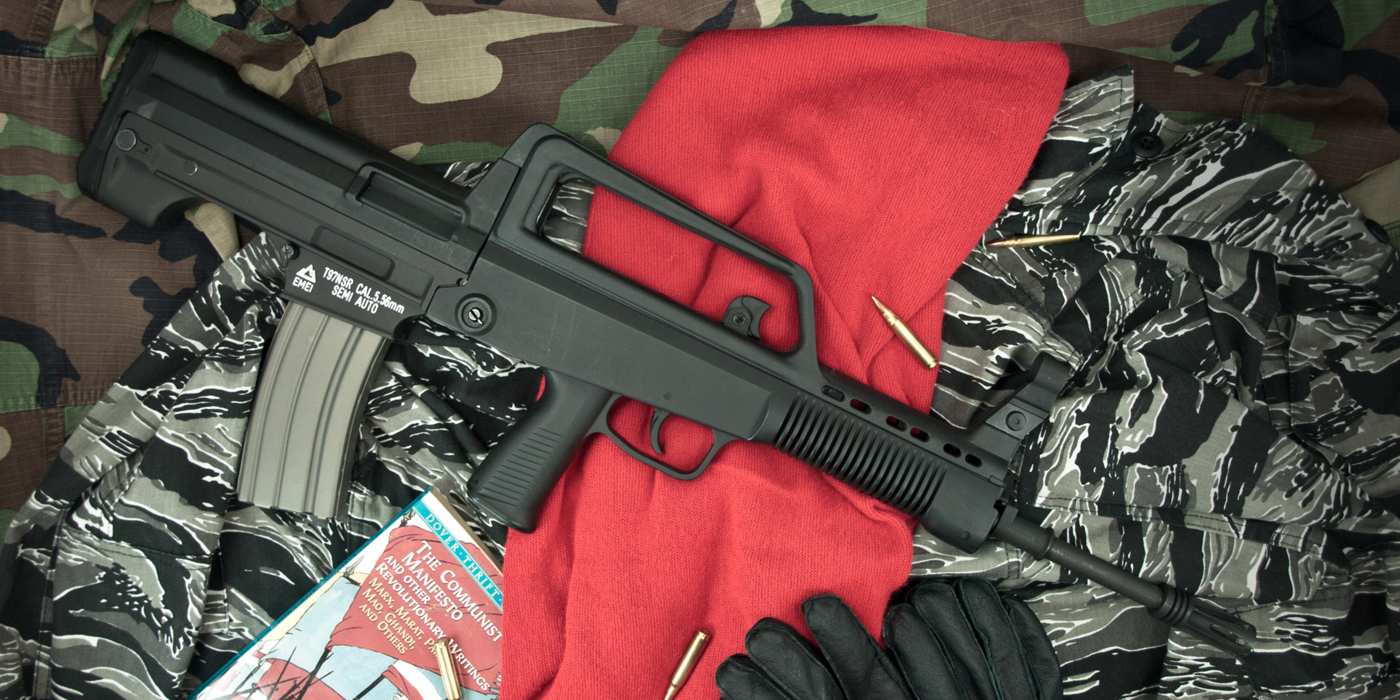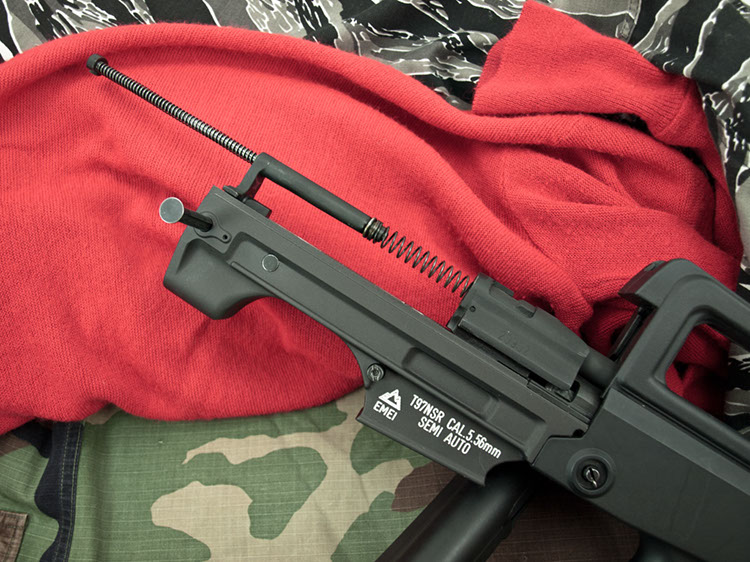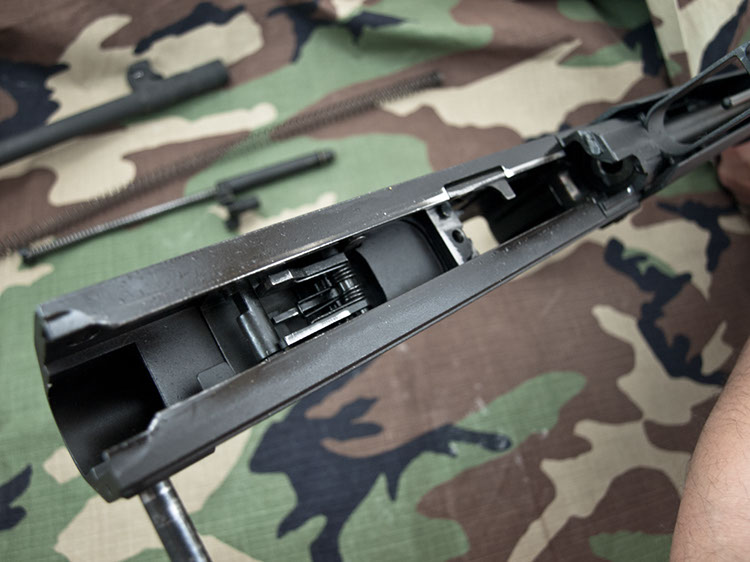
In the 1970s and early 1980s, militaries around the world found themselves at the forefront of an arms race the likes of which the world had never known. While the world's political climate remained muddled under the ever-present threat of the Cold War, armies under both NATO and COMINTERN directives were wildly attempting to apply the lessons learned on the battlefields of World War II, Korea, Vietnam, and Afghanistan to further evolve the military rifle, all in an effort to prepare for the eventuality of war. A process that had already seen the world's superpowers trade their heavy and hard-hitting battle rifles in favour of vastly
smaller and more compact assault rifles that took inspiration from the German StG-44, all that remained was for the world's smaller and more independent countries to apply these same lessons for themselves. And not surprisingly, many did, in entirely predictable fashions. The Swiss, for example, devised an expertly engineered and superlatively-made rifle capable of both an extremely long service life and astounding accuracy... not unlike the majority of their previous service rifles. We Canadians, in a similarly expected fashion followed in the footsteps of our greatest ally in adopting a slightly modified version of their M-16 rifle, resulting in the then-Diemaco C7 program. But amidst all this banal progress lie one hugely different design: the Austrian Steyr AUG.
Both radically different due to its layout as well as its construction, the AUG combined an innovative bullpup layout with an equally unconventional polymer material to devise a rifle that weighed less and was dramatically more compact than many of its contemporaries. Some derided its polymer construction and claimed that plastic had no purpose on a fighting rifle, saying it would prove ill-tempered and unreliable. Others claimed the manual of arms required to operate bullpup rifles was too awkward under the best of conditions, and nigh impossible under the worst. But that certainly hasn't stopped the AUG from spawning more than a few very effective military bullpup rifles, including the British L85, Israeli Tavor, and most pertinent to this particular review, the Chinese QBZ-95.
Originally developed alongside China's first widespread intermediate cartridge, the 64-grain 5.8x42mm DBP87 round, the QBZ-95 rifle borrowed heavily from the Austrian AUG's design. Cribbing both the AUG's revolutionary bullpup design and its extensive use of polymer materials, the QBZ-95 ("Qing Buqiang Zu," or "light rifles family") was rolled out for the Chinese military in 1995, and remained a closely-guarded state secret until 1997, when Chinese guards were spotted with the futuristic rifle at the handover ceremony of Hong Kong. In keeping with the modern ethos of modularity, the Chinese military didn't limit the new QBZ-95's layout and design to just one gun, subsequently issuing a smaller and lighter version known as the QBZ-95B carbine, as well as the QBB-95 light support weapon fitted with a longer and heavier barrel, a faster fire rate, and 80-round drum magazines. However, while Chinese officials claimed the QZB-95 paired the accuracy of the American M16A3 with the reliability of the Russian
AK-74, by 2010 some valuable lessons had been learned with the new rifle. Most notable of these changes was the moving of the four-position fire selector switch (safe, semi-automatic, fully automatic, and three-round burst). Initially located near the magazine well, it demanded soldiers remove their hand from the rifle to disengage the safety, so a design team re-engineered the QBZ-95 and relocated the safety above the pistol grip in a manner not unlike that of the Israeli Tavor. Next, the polymer stock was stengthened, and the barrel made heavier and slightly longer in order to fire the equally new and slightly heavier DBP10 round. A bolt hold-open and release was also added, while the hand guard and pistol grip were made more ergonomic. Interestingly, the rifle's ejection was also revisited, and the updated QBZ-95-1, QBB-95-1, and QZB-95B-1 (as the post-2010 models are known) now eject their casings to the right at 1 o'clock, throwing the brass so far forward so as to facilitate left-handed shooting.
But while all these changes were undoubtedly of interest to the average Chinese soldier, for those of us in Canada, it was the debut of one model in particular that proved of interest: the QZB-97, or Type 97. Produced by Norinco as the export model of their own QBZ-95, the semi-automatic Type 97 utilized much of the same action and design of the Chinese rifle, but traded the unique and strictly controlled Chinese 5.8x42mm round for the much more ubiquitous 5.56 NATO round. Obviously, that also meant replacing the QBZ-95's AK-style magazine and shallow rock-and-lock style magazine retention system with STANAG-friendly components, and in the case of the Type 97NSR that we Canadians can now buy, also utilizing a different receiver in order to accept a unique trigger group, as well as a few other modifications.
But enough with the background. We know there's only one question on everyone's mind right now: is it a piece of Chinese-made crap? In a single word that does not even begin to answer that question with the gravitas this rifle deserves; no.
Now, anyone that's tinkered with any amount of Norinco products can understand how some might question that assessment. There are, after all, plenty of examples of Norinco-branded workmanship already floating around the Canadian marketplace, and they range in quality from serviceable to relatively poor. But this large variance in quality can be traced largely to Norinco's own vastness: with over 150 factories scattered around China manufacturing everything from single-shot .22s to trucks and motorcycles to missile systems to tanks, it is not incomprehensible that fit and finish of their exported firearms (which themselves emanate from four to five different factories) may fluctuate from lineup to lineup. But the Type 97NSR is a bit different. Manufactured in one of the top two facilities in China, Type 97NSR feels unlike most other Norinco firearms, and at least seems to be made to a standard that is on par with most rack-grade military rifles.

With the butt pad assembly removed, our breath restored, and the bolt carrier similarly removed, it's quite easy to figure out how the Type 97NSR operates. Forced backward by its three-position gas piston assembly mounted ahead of the handguard, the bolt carrier assembly slides to the back of the gun just underneath the comb, travelling rearward on a pair of steel rails that comprise the top of the lower receiver. Located directly in line with these rails, the oddly-shaped rotating bolt head locks into place in the barrel extension via its three beefy lockup lugs, and when removed makes cleaning the chamber and barrel extension a breeze. It's certainly easier to clean than an AR-15, due to both the barrel extension's more accessible position within the receiver as well as the greater access granted by the larger asymmetrical three-lug design.

Once disassembled the most poignant and immediately noticeable aspect of the Type 97NSR is its uniquely sparing design. Manufactured from as few components as possible and using a minimum of machining processes, there aren't any superfluous pieces or excessive fasteners anywhere to be found; everything that needs to be fitted together is done so in the most minimalistic manner possible. The entire upper hand guard, for example, is simply wedged under the front sight base and retained by the upper receiver... nothing more. Things like this make the Type 97NSR very easy to maintain, and also contribute to its enviable price tag... but they also make it slightly less luxurious than some of its competitors. It is, if you will, not entirely dissimilar from the design ethos popularized by Gaston Glock in that the Type 97NSR, like Glock's inimitable polymer pistol, trades luxury and looks for affordability, durability, and simplicity.
But before anyone screams that it would be sacrilegious to compare a rifle devoid of provenance, such as the Type 97NSR is, to one of the most popular and proven pistols on planet Earth, hear this: having spent a day shooting any and every type of ammunition we could out of it, the praise that was heaped upon it by everyone from our own staff to the experienced range officers who shot it varied from merely glowing to absolutely superlative. In short, this thing shoots like a house afire. Even shooting it from a right-handed position (yours truly being afflicted with left-handedness from birth), in less than ideal conditions, through its somewhat unfriendly sights yielded groups as small as 1.5 MOA at 100 yards. That'd be considered good for any battle-ready rifle, and when combined with the Norinco's $999 price tag, was a most pleasant surprise.
The credit for that accuracy stems from a two things; obviously pretty good manufacturing tolerances throughout, and a very good (for a bullpup) trigger. The latter makes itself quite apparent as you manipulate the gun, everything from the admittedly awkwardly-placed safety to the charging handle all operating with a nice, slick feel that doesn't take an overabundance of effort. The charging handle, specifically, was one of the smoothest we've come across, and the feeling you get when charging the gun is that of simply compressing and releasing a spring; you don't feel the friction of the bolt riding over a round in the magazine nor do you feel the resistance at it encounters and sets the hammer... it's just one butter-smooth pull backwards against an almost perfectly linear amount of resistance. Likewise, everyone was pleasantly surprised by the rifle's ejection. Proving that the Type 97NSR combines both a well made and efficient piston-driven gas system with an astoundingly slick action, the Type 97NSR threw brass quite consistently towards the 1:30 position, and tossed it well over neighbouring 6-foot tall target backers set at the 7 yard mark... and did so on the lowest of the two gas settings!
The other feature owed credit for the Type 97NSR's accuracy, as mentioned, is its excellent trigger. Obviously being a bullpup design, the trigger blade acts on an interal linkage that runs nearly the length of the receiver, and the additional joints this design introduces between the trigger blade and the sear obviously detract from the trigger's feel and crispness. In this regard the Type 97NSR is no different from any other bullpup. Thankfully, some of that excess movement is accounted for by the Type 97NSR's usage of a two-stage, military-style trigger that sees the majority of the trigger pull dedicated to taking up slack in the system, with a second stage of roughly the same 4.5-pound weight as a USGI AR-15 trigger group used to release the hammer. That second stage does still have some mush to it though, but it's only marginally worse than the creep found in most rack-grade rifle triggers, and remains smooth throughout. During our testing, that made it easy to maintain a consistent effort through your finger until it fires, and we have no doubt that more trigger time and perhaps a bit of trigger work would yield excellent results.
But while it shoots exceedingly well, if the Type 97NSR has a weakness, it has to be its ergonomics. As a left-handed shooter, there's simply no getting around the issue of the Type 97NSR's innate right-handedness, and before you ask, Norinco will not be manufacturing any left-handed guns any time soon. Can you stick the gun in your left shoulder and make it work? Yes, and the gun does allow for that without blowing excessive amounts of carbon and hot gases all over your face during ejection. However, doing so requires the head be drawn way too far back on the stock to be comfortable, and even then, anyone that tried shooting it left-handed had at least one casing graze their upper lip. But hey, at least the regular singing of your facial hair will save you some money on razor blades.
The next major issue is that of the magazine release. Having its genetics founded in the QBZ, which uses rock-and-lock, AK-style magazines that release from the rear (think CZ858), the Type 97NSR has been significantly redesigned to accept STANAG, or AR-15 style magazines, which use a cross-bolt method of retention. This, combined with the recoil buffer built into the lower rear of the receiver means that the Type 97NSR had to use a traditional AR-15 style magazine release. The only problem is that the magazine release button remains on the right-hand side of the receiver, which means it must either be manipulated by some strange contortion of the left hand or by taking your right hand of the pistol grip. Obviously neither of these situations are ideal, and North Sylva has told us that they're currently working towards the incorporation of a Norgon-style ambidextrous magazine release to alleviate the problem. Also, it should be noted that the rifle has no bolt hold-open or release, so holding the action open for a target change or safety check requires either racking the action over an empty magazine or sticking your finger inside the magazine well to manually push the internal hold-open mechanism into the bolt's travel. Releasing a locked-back bolt is only accomplished by tugging on the top-mounted charging handle.
Finally, there is the issue of the Type 97NSR's carry-handle, and its integrated iron sights. The sights are quite typical for a modern mass-produced, rack-grade military rifle, and as such allow just enough adjustment to prove serviceable. But they're still a little odd. The rear aperture, for example, features three peep-sights labelled 1, 3, and 5 (we surmise these correlate to yardages), but to our eyes simply seemed to feature larger openings rather than the same-sized opening repositioned to account for bullet drop over the various distances. The rear sight's fourth position features a vertical blade that is best used for drawing confused looks from would-be rifle borrowers as they look down the sights and see what appears to be two front sights.
But the real issue for most will be that those sights are all that will be available to help them aim their rifle, at least for the time being. The Type 97NSR does feature the Chinese QBZ-style optic mount rail system in the carry handle, but the PLA-spec optic mounts that use said rail are prohibitively expensive to export, and thus are not available to Canadian consumers. Conversely, another aiming option available to PLA members in China incorporates a rail that mounts an optic just aft of the front sight in a sort of bullpup-cum-scout-rifle style layout, but again, is not yet available. And in both cases, the required existence of that tall carry handle means any optic mount will have to position the glass quite high above the bore axis, which will in turn restrict most to using either red-dot or holographic optics, or small objective-equipped, minimal zoom CQB style scopes. However, given the assured popularity of the Type 97NSR, we have no doubt that it will be just a matter of months before something shows up to remedy the issue of mounting optics on the rifle.
While we certainly were floored by the performance put up by this, the most anticipated rifle in recent memory, there's one massive factor that underpinned all our findings: the price tag. With a retail price of just $999, the Type 97NSR is an unequivocal bargain. Built to a standard that would befit a gun costing much more, shooting incredibly well, and most importantly classified as a non-restricted rifle, it finally gives Canadians access to that perfect formula: a compact, .223-firing semi-automatic rifle that uses STANAG magazines, but is cheap enough to beat on, throw around, and generally use without worrying about devaluing an item in which one may have invested two to three thousand dollars. Of course, as with any product that's as heavily anticipated as this, chances are good that initial shipments (which are slated to arrive early this fall) will have largely already been spoken for by the time they cross retailers' thresholds, but suffice to say that this rifle is definitely here to stay. Now if you'll excuse us, we're got some right-handed shooting drills to work on.
The rifle that any and all PAL-holders will soon be available for purchase in your local gun shop (delivery is expected this fall), is crucially different from the Type 97 everyone expected a few years ago. Having first made Canadian landfall in 2009, the original Norinco Type 97A initially expected to break the black rifle market open in a way few other rifles had ever promised to do; providing Canadians with a compact bullpup-style rifle that both fed from AR-style STANAG mags and digested widely available .223 Remington ammunition without complaint, all while maintaining the all-important non-restricted designation. But it all came off the rails when the first vaunted shipments arrived in 2010 only to be seized by the authorities. According to RCMP statements, testing of sample rifles' within the Firearms Program's lab revealed that the particular rifles contained in these initial shipments, previously deemed to be unrestricted rifles, incorporated trigger groups that could be made to operate in a fully automatic manner with simple hand tools and minimal time. Thus, the Type 97A was reclassified as a prohibited firearm, and all civilian-held examples duly seized. But in a rare example of hope springing eternal within the Canadian firearms marketplace, North Sylva distributors decided to take their own kick at the Type 97 can shortly thereafter, recognizing the deficiencies in the original Type 97A's design and addressing the primary issue with an entirely new trigger design of their own creation, as well as a few other undisclosed modifications. The subsequent rifle, called the Type 97NSR (North Sylva Rifle), has thus sidestepped any issues that may have plagued the original Norinco Type 97A's design